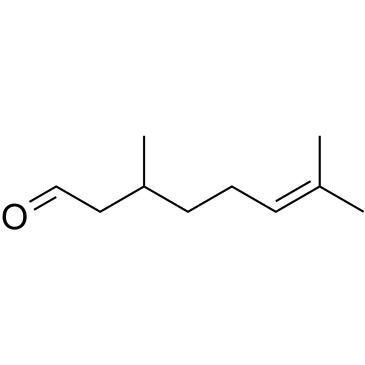Citronellal

Citronellal structure
|
Common Name | Citronellal | ||
|---|---|---|---|---|
| CAS Number | 106-23-0 | Molecular Weight | 154.249 | |
| Density | 0.8±0.1 g/cm3 | Boiling Point | 208.4±9.0 °C at 760 mmHg | |
| Molecular Formula | C10H18O | Melting Point | N/A | |
| MSDS | Chinese USA | Flash Point | 75.6±0.0 °C | |
| Symbol |


GHS07, GHS09 |
Signal Word | Warning | |
|
Circuit formation and function in the olfactory bulb of mice with reduced spontaneous afferent activity.
J. Neurosci. 35(1) , 146-60, (2015) The type of neuronal activity required for circuit development is a matter of significant debate. We addressed this issue by analyzing the topographic organization of the olfactory bulb in transgenic mice engineered to have very little afferent spontaneous ac... |
|
|
The Mosquito Repellent Citronellal Directly Potentiates Drosophila TRPA1, Facilitating Feeding Suppression.
Mol. Cells 38 , 911-7, (2015) Citronellal, a well-known plant-derived mosquito repellent, was previously reported to repel Drosophila melanogaster via olfactory pathways involving but not directly activating Transient Receptor Potential Ankyrin 1 (TRPA1). Here, we show that citronellal is... |
|
|
Electrophysiological and behavioral characterization of bioactive compounds of the Thymus vulgaris, Cymbopogon winterianus, Cuminum cyminum and Cinnamomum zeylanicum essential oils against Anopheles gambiae and prospects for their use as bednet treatments.
Parasit. Vectors 8 , 316, (2015) Laboratory and field studies showed that repellent, irritant and toxic actions of common public health insecticides reduce human-vector contact and thereby interrupt disease transmission. One of the more effective strategies to reduce disease risk involves th... |
|
|
Monoterpene (-)-citronellal affects hepatocarcinoma cell signaling via an olfactory receptor.
Arch. Biochem. Biophys. 566 , 100-9, (2015) Terpenes are the major constituents of essential oils in plants. In recent years, terpenes have become of clinical relevance due to their ability to suppress cancer development. Their effect on cellular proliferation has made them promising agents in the prev... |
|
|
Evaluation of the masking of dimethyl sulfide odors by citronellal, limonene and citral through the use of trained odor sensor mice.
Chem. Senses 38(1) , 57-65, (2013) Previous studies indicate that the most common result of mixing two odors is the decreased olfactory perception of one or both components in the mixture. An excellent example of this phenomenon is provided by the masking of an unpleasant odor by a pleasant od... |
|
|
Citronellal, a monoterpene present in Java citronella oil, attenuates mechanical nociception response in mice.
Pharm. Biol. 51(9) , 1144-9, (2013) Citronellal is a monoterpene present in the oil of many species, including Cymbopogon winterianus Jowitt (Poaceae).The present study investigated the effect of citronellal on inflammatory nociception induced by different stimuli and examined the involvement o... |
|
|
Extracting the Behaviorally Relevant Stimulus: Unique Neural Representation of Farnesol, a Component of the Recruitment Pheromone of Bombus terrestris.
PLoS ONE 10 , e0137413, (2015) To trigger innate behavior, sensory neural networks are pre-tuned to extract biologically relevant stimuli. Many male-female or insect-plant interactions depend on this phenomenon. Especially communication among individuals within social groups depends on inn... |
|
|
Repellency of the Components of the Essential Oil, Citronella, to Triatoma rubida, Triatoma protracta, and Triatoma recurva (Hemiptera: Reduviidae: Triatominae).
J. Med. Entomol. 52 , 719-21, (2015) The kissing bugs--Triatoma rubida (Uhler), Triatoma protracta (Uhler), and Triatoma recurva (Stal)--are common hematophagous bugs in southeastern Arizona and responsible for severe allergic reactions in some individuals who are bitten. They also possess the p... |
|
|
On the synergistic catalytic properties of bimetallic mesoporous materials containing aluminum and zirconium: the Prins cyclisation of citronellal.
Chemistry 17 , 2077-88, (2011) Bimetallic three-dimensional amorphous mesoporous materials, Al-Zr-TUD-1 materials, were synthesised by using a surfactant-free, one-pot procedure employing triethanolamine (TEA) as a complexing reagent. The amount of aluminium and zirconium was varied in ord... |
|
|
Characterization of biofumigated Ralstonia solanacearum cells using micro-Raman spectroscopy and electron microscopy.
Phytopathology 102(1) , 105-13, (2012) Essential oils of palmarosa, lemongrass, and eucalyptus have shown promise as biofumigants for control of the bacterial wilt disease of edible ginger (Zingiber officinale) caused by Ralstonia solanacearum race 4 in previous potting medium studies. Biochemical... |